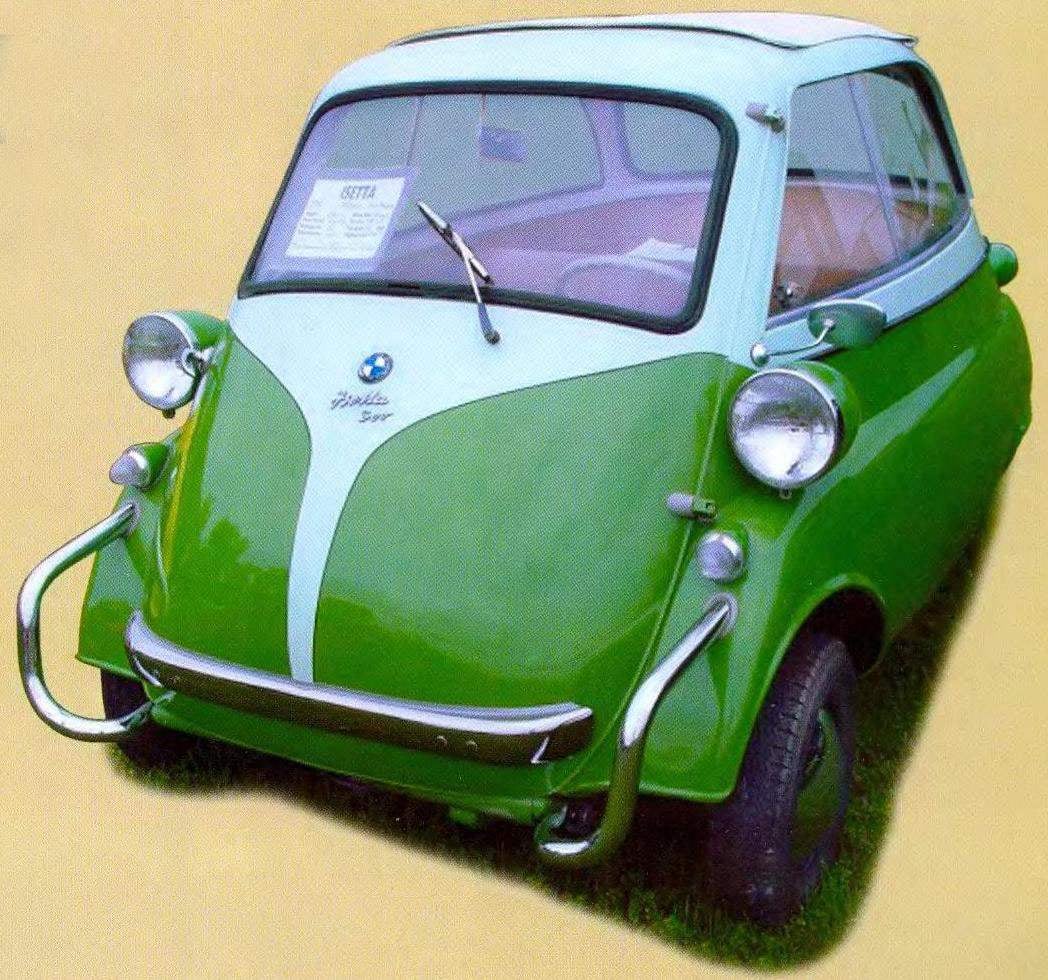Interestingly, in post-war Germany for several aviation firms, find themselves out of work, have also started to build compact cars — the idea of production of such machines, as can be seen, hovering in the air. In particular, the famous aircraft firm Heinkel had designed a little different in appearance from the little micro-car three-wheeled ISETTA Heinkel-Kabine, and the famous Messerschmitt company developed the tricycle in which the driver and the only passenger were arranged in tandem in the cockpit, closed the transparent canopy is almost the same as the double attack aircraft. A completely independent design was developed by German company Glas — it was a compact sedan, the Goggomobil two-stroke 0,25-liter engine.
1957 ISETTA was first produced under license by BMW in the UK — of course, in right-hand drive version and, unlike the countries on the other side of the English channel, with three wheels. However, the driver and engine were on the right side minicar, and for optimal weight distribution on the wheels designers had on the left side to accommodate a 27-pound load. Well, the removal of the car two wheels due to the fact that in England, three-wheeled vehicle with a motorcycle engine and no reverse gear was equal to the motorcycle with the appropriate tax incentives and simplified licensing.
![Despite the low-power engine and wheels of small diameter, ISETTA nice]()
Despite the low power the engine and wheels of small diameter, ISETTA nice “feel” like on dirt road
The British variant of the BMW ISETTA had three wheels and located the wheel to the right
Tricycle Heinkel-kabine — car-twin BMW ISETTA
The cabin of the BMW ISETTA
The basic controls a little micro-car:
1 —the lever transmission; 2—a control lever a heater; 3—horn button; 4 — the switch of a plafond of illumination of salon; 5—the switch of indexes of turns; 6—the switch wiper; 7—the ignition lock and the starter switch; 8—signal light generator; 9—speedometer with a pointer to the traversed path; 10—signal lamp repeater Blinker; 11—the switch of light of headlights
The four-stroke BMW ISETTA working volume of 0.25 l
The driver
Three-wheeled Messerschmitt Kabinenroller firms have good aerodynamics and good high-speed qualities
Domestic microcar С3А as to its performance differed from the foreign car-classmates
BMW 600 — the last of a series of subcompact car company Bayerische Motorenwerke
The BMW firm in the next year or two plans to launch a series of car called the ISETTA, made “based on” mini-cars of the 1950s years
In the early 1950-ies miniature cars produced in France, in particular, the firm CITROEN is very successfully sold mini cars Citroen 2SV, and the company produced the licensed Velam ISETTA.
Not remained aloof and Soviet designers. In the 1950-ies on the Serpukhov plant, they created the first three-wheeled microcar С1Л, which was then replaced by a four-wheel two-door convertible С3Д with a canvas retractable roof, and completed this series all metal car С3Д. All these machines were equipped with single-cylinder motorcycle engines. Unfortunately, sidecar is not intended for sale to the public — they were distributed by the social welfare authorities as a vehicle for the disabled. By the way, the Amateur designers happy to have acquired overage sidecar — on this basis, we created a considerable number of self-made cars.
The post-war crisis, meanwhile, was declining, and buyers have started to increasingly look for “real” cars. Trying to keep up with the times, BMW once again upgraded ISETTA, this time quite radical. Little micro-car extended, making it a quadruple, brought the track of the rear wheels to track the front and equipped it with 2-cylinder boxer four-stroke engine, with a volume of 0,6 liters. The result was a kind of transition from the little micro-car to a small car called the BMW ISETTA 600. After it was released ISETTA with engine capacity of 0.7 liters and new body “pontoon” type. However, the time sidecars were gone — the last one by BMW released in 1962.
Technical characteristics of BMW ISETTA micro-car, only
Model………………………………………250/300
Years of production……………………..1955 – 1957
Length, mm……………………………………….2285
Width, mm………………………………….1380
Height, mm………………..1340
Bacha, mm………………………………….1500
The front track of wheels, mm…………1200
Rear track, mm……………………..520
Dry weight, kg…………………………………360
Engine type………………four-stroke
Working volume, l……………………..0,25/0,30
Power, HP……………………………….12/13
Drive…………………………rear-wheel
Brake……..drum, hydraulic
Maximum speed, km/h……………..85
Wheel………………………………………..4,80-10
Recommend to read
 DRY T4 (100)
DRY T4 (100)
The competition of the State Committee on aviation technology to establish the impact of a missile to destroy aircraft carriers was announced in September 1961. In the fight for the... GLIDERS LIDIA KOCHETKOVA
GLIDERS LIDIA KOCHETKOVA
Start 30-ies was a time of rapid development of Soviet gliding. The newly constructed plant produced serial training gliders and sent them to all parts of the Soviet Union for gliding...

 Little micro-car BMW ISETTA. This has happened more than once. Crest of the economic crisis, the Great depression or the post-war ruin — and instead of the heavy limousine with big motors car company suddenly started to produce a compact and inexpensive cars that are in high demand from impoverished buyers. The result is a miniature sidecar pulled from the verge of bankruptcy that created them, car companies, and they, in turn, pulled out of the crises and the country’s economy.
Little micro-car BMW ISETTA. This has happened more than once. Crest of the economic crisis, the Great depression or the post-war ruin — and instead of the heavy limousine with big motors car company suddenly started to produce a compact and inexpensive cars that are in high demand from impoverished buyers. The result is a miniature sidecar pulled from the verge of bankruptcy that created them, car companies, and they, in turn, pulled out of the crises and the country’s economy.